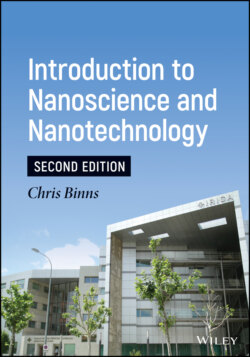Читать книгу Introduction to Nanoscience and Nanotechnology - Chris Binns - Страница 15
I.4 Bottom–Up/Top–Down Nanotechnology
ОглавлениеFinally, in this introduction it is worth mentioning another way of categorizing nanotechnology, that is, bottom–up and top–down approaches. Everything discussed so far has been part of a bottom–up approach in which the building block (nanoparticle, molecular machine component, etc.) is identified and produced naturally, and then assembled to produce the material or device required. The top–down approach starts with a block of material and machines a device or structure out of it. This is akin to conventional engineering using lathes and millers to machine a shape out of a solid block. The modern tools of nanotechnology, however, are able to machine structures with sizes of a few nanometers, so the size of components made with a top–down approach is not much different to the building blocks of the bottom–up approach. The flexibility of top–down tools, in particular, focused‐ion beam systems (FIB's), is further enhanced by their ability to deposit material to produce nanoscale features as well as to remove it. This is beautifully illustrated in Figure I.6, which shows an example of a “wine glass” with a cup diameter 20 times smaller than the width of a human hair produced by depositing carbon. Although this is a rather big structure on the scale of nanometers, the smallest feature size that can be produced by a modern FIB is less than 20 nm.
Figure I.6 The smallest wineglass in the World (authorised by Guinness World Records). Wine glass whose cup diameter is 20 times smaller than the width of a human hair produced by deposition of carbon using a FIB machine. The structure arose from a Joint development by SII NanoTechnology, NEC, and the University of Hyogo, Japan. Although this is a rather big structure on the scale of nanometers, the smallest feature size that can be produced by a modern FIB is less than 20 nm (see Chapter 5, Section 5.2.2).
Figure I.7 Top–down nanotechnology used to attach electrodes to a nanoparticle. (a) Electron microscope image of electrodes produced by electron beam lithography to attach to a single gold nanoparticle that acts as a single‐electron transistor. (b) Artistic rendering of the set‐up showing the equivalent circuit.
Source: Images reproduced from [10] under creative commons license CC BY‐SA 4.0.
The two approaches (top–down and bottom–up) are complementary, and some of the most exciting research arises out of combining them. For example, if one wants to measure the electrical or magnetic properties of an individual nanoparticle, the fantastic precision of a modern top–down tool enables the production of electrodes that can attach to it. An example is demonstrated in Figure I.7, which shows source, drain, and gate electrodes, produced by electron‐beam lithography (see Chapter 5, Section 5.2.1) applied to a single gold nanoparticle acting as a SET, as described earlier.
The above is an attempt at a lightning tour of nanotechnology with generic descriptions and without addressing details. The rest of the book looks in detail at these and other aspects of nanotechnology. Chapter 1 aims to instil a feeling of how small the nanometer length scale is in comparison to macroscopic objects and why it is special. It discusses the basic conception of the discrete nature of matter starting from the original philosophical ideas of Leucippus and Demokritos of ancient Greece to the modern view of atomic structure. It also describes why the properties of pieces of matter with a size in the nanometer range (nanoparticles) deviate significantly from the bulk material and how these special properties may be used to produce high‐performance materials and devices. In Chapter 2, the discussion is broadened to include naturally occurring nanoparticles, both in the Earth's atmosphere and in space. Chapter 3 is dedicated to nanoparticles composed of carbon, and the justification for devoting a chapter to a single element is the rich variety of nanostructures produced by carbon and their importance in the rest of nanotechnology. Chapter 4, which is new to this edition, continues with carbon and is devoted to a single structure, that is, the two‐dimensional form, graphene. This has become a huge area of research since Edition 1 was published and its potential applications justify a chapter dedicated to it. Chapter 5 presents the tools of nanotechnology that can build, image and manipulate nanostructures to build materials and devices using a bottom–up approach. It also describes top–down manufacturing methods that are capable of shaping nanostructures and perhaps one of the most exciting aspects of the field, that is, combining bottom–up and top–down approaches so that individual nanostructures can be probed as illustrated in Figure I.7. Chapter 6 is about artificially produced nanostructures that have a built‐in functionality. Examples presented include magnetic nanoparticles that store a data bit, nanoparticles that function as transistors, quantum dots, which behave as “artificial atoms” with novel optical and electronic properties, nanotube relays and linking structures with proteins.
Chapter 7 is new to this edition and presents nanoparticles in liquids (hydrosols), nanobubbles, and the science of nanoscale interfaces. Chapter 8 shows how combining advances in the production of nanoparticles and in biotechnology, it is possible to produce biologically active nanoparticles that can interact with specific cells in the body. These can then be used as nanoscale amplifiers in biological images, or they can be used to destroy their attached cells under the application of external stimulation, such as radio frequency waves or infrared radiation leading to powerful new treatments for cancer. Chapter 9 presents radical nanotechnology and discusses the potential for building nanofactories and autonomous machines with nanoscale components. Chapter 10 discusses how the tools of nanotechnology can be exploited to study the basic nature of vacuum itself via the Casimir effect. This is a strange “force from nothing” that arises from the zero‐point energy density of empty space. The Casimir force also has practical applications in nanotechnology and new experiments have shown how to manipulate it to practical advantage in nanomachines.
